AutomatedBuildings.com
Article - May 99
[Home Page] |
[an error occurred while processing this directive]
(Click Message to Learn More) |
|
|

Authors: Ken Sinclair, Member Sinclair Energy Services
Ltd., Sidney, BC, Canada Cedric Trueman, P.E., Member Trueman Engineering Services,
Victoria, BC, Canada |
When this
demo was originally created it was unclear whether our industry would support Adobe's
Acrobat Portable Document File format since it was a proprietary file format. The fact
that Adobe provides the PDF reader free, and PDF does a much better job of printing than
HTML, has caused the industry to support this format. Many manufacturers now offer their
technical bulletins in PDF. The excellent interaction of PDF and HTML allow this article
to be reread using HTML to serve either PDF or HTML files. |
HTML as a Documentation Medium for Building O & M
Toronto ASHRAE Annual Meeting 6/21/1998
Introduction
The purpose of this presentation is to provide some
information on an alternative form for operations and maintenance documentation for
buildings. That alternative form is computer files using HyperText Markup Language (HTML),
and residing on a computer workstation.
HTML is, as many of you will know, the language of the
Internet. The concept is to make O & M documentation available in a form that is as
readily available to the building operator as data on the World-Wide Web is available to
anyone with Internet access on their home or business computer. It is essentially an
off-line application of Internet data concepts.
Practical application of this concept is available right now.
Any building with a DDC system, and having a computer workstation interfacing to the
system, can use that same workstation to hold HTML-based O & M documentation.
Why HTML?
HTML is a good choice of medium for documenting building
mechanical and electrical Operating & Maintenance information for your projects,
including energy and comfort optimization strategies. HTML offers many features of value
in an O & M documentation application:
- It allows graphics and text information to be mixed.
- Hypertext links between files are easy to set up.
- Word searches within files are a feature of the software.
- Data in paper form can be easily scanned into the computer
system and form part of the documentation.
- Access to, and authority to revise the files, can be limited
by password security.
- HTML is able to run on most major computer operating system
platforms that support an HTML browser.
- Provision can easily be made for the building operator to
update the information, insert questions to be answered, etc. in order to make the
information as relevant, complete and useful as possible.
- For those who really get into this, an interactive multimedia
presentation, customized for your application, can be created.
Documenting in this method allows an interactive electronic
legacy to be left on the operating computer for the project.
What Can HTML Multimedia Environments Mean to Our
Industry?
The short answer is that it means there is an exciting new
interactive medium that can be used to provide better and more usable O & M
documentation. The use of HTML is constantly growing and improving because it is the
language of the Internet. It is highly portable and internationally accepted. In fact, O
& M documentation using HTML is like having a local WWW on a single computer, or a
local network of computers. Such a network, when using HTML files, a browser, and perhaps
a custom search engine, is termed an Intranet.
The new generation of HTML browsers allows close desktop
operating system integration. It allows the simple assembly of easy to use, highly
functional, PC-based, multimedia, linked HTML files.
Information from many sources can be quickly assembled into
electronic form using any one of the many powerful HTML editors available today.
If information is already available in electronic format, it
can be simply read into the HTML environment. Manufacturer information, balancing reports
in a spreadsheet format, or sequences of operation from specifications might be examples
of this.
Traditional paper documentation can be included by scanning
and Optical Character Recognition (OCR) software. Successful scanning requires a clean
original, preferably using a simple font. Even then, the resulting file needs to be
reviewed and edited to correct any scanning errors. Also, text and graphics information
should be scanned separately into different files. Once they are in electronic files, then
they can be recombined as needed.
Actual operating data, for example trendlogs from the DDC
system which illustrate correct operation, can be captured and included as diagrams
alongside text explaining the operation being illustrated.
Most newer word processing and spreadsheet programs are able
to generate HTML files directly. A typical approach would be to set it up in a very
familiar manner. There will be a “main menu” or table of contents page, or file.
Then there will be files for each of the various systems and topics to be covered in the
manual. These will all be linked to the table of contents, so clicking a mouse on a table
of contents item will automatically cause that item to be displayed. All the abilities of
the browser being used, such as “Forward”, “Back”, “Print”,
“Edit”, etc. are available to the user. The new generation of browser software
can launch other applications and files, which leads to the simple custom generation of
easy to use, highly functional, integrated project information from all sources.
The resources required to generate this information can be
reused on each project as core information, and can be edited to quicken assembly of
similar information for additional projects. HTML files are easily edited remotely and
emailed to site as attached files, or can be edited on site by operator, to provide
accurate quickly changing information. If a new contractor or consultant comes to the
project, orientation and general explanation time can be greatly reduced by reviewing the
HTML site before asking questions.
Where this approach to O & M documentation has been
introduced, it has been well received, particularly by younger, computer-literate
operators. In fact, one of the exciting aspects of this electronic approach to
documentation is that, in a very real sense, it has no boundaries. There are so many new
ways of doing things being discovered in the computer world today, that what is new, or
optimum, today may well become obsolete or passť tomorrow.
In fact, it is entirely likely there are people in this
audience who know more about how to create and use this sort of “soft”
documentation than I do. The only reason I’m up here is that the organizers of this
session don’t know who you are. By all means talk to the session chair, or any of the
speakers today. Offer to share your knowledge with your colleagues in ASHRAE. It will help
you, and it will help our industry.
Resource Library for a Building Operator’s
Laptop [an error occurred while processing this directive]
There is no limitation to the information that can be
included in PC-based O & M documentation. The following would be a typical list of
options:
- Client contact information;
- Contractor contact information;
- Air balance reports which launch data and application
spreadsheets;
- Product information; any paper based information can be easily
scanned in, or information can be downloaded from the vendor’s web site;
- Copies of, or links to, applicable standards or codes;
- Copies of employer-mandated procedures - e.g. IAQ complaint
process;
- Frequently used engineering data, conversion charts, etc.;
- Anything which would otherwise be on a piece of paper taped to
the wall, bulletin board, or wherever the operator could see it quickly.
- In summary, anything which would be in a conventional O &
M manual, and more.
A standard shell or document format can be developed into
which information for specific buildings is entered. A multi-building owner may develop a
custom shell, to suit organizational operating needs.
Access to the documentation can be easily launched from a
desktop, via a shortcut link to the “start HTML” file. Clicking on the HTML file
will invoke the default browser and launch the complete application. The electronic
documentation can be set up so pertinent information is presented by pointing and clicking
on Hypertext “hot spots” in a graphical representation of the building or one of
its systems.
This new media is well received by users as it requires
almost no introduction or learning curve. We are excited about its use in both new and
existing projects.
Documenting System Operating Intent Using HTML
Comfort and energy performance intentions and goals need to
be documented, and in a format that can be completely understood by the building
operators. Results can then be compared to goals, and adjustments made as needed. The use
of the computer and HTML facilitates documentation of both the original goals, but also
any revisions. One goal is to communicate this information effectively to the people
actually operating the building. Its achievement, however, will take more than technology.
Operator training and familiarization in how to understand and use the information made
available is an essential ingredient in the overall O & M documentation picture.
The documentation can include actual pieces of screen
captures from the operating Direct Digital Control system. This concept lets you actually
demonstrate graphically the desired operating parameters that the designer felt should be
achieved. This is extremely useful for demonstrating how operators should use the system
to achieve the optimum client comfort within a least energy use strategy. An example of
this is to capture hourly and daily energy graphs that depict successful operation and
provide them as a goal for the operator to achieve and maintain. The operating intent can
be effectively documented in this manner and circulated to the Owner, all involved
contractors, consultants and the building operator for concurrence.
It is important for everyone to know that the documentation
left on the on site computer will be operator-friendly, and contain usable information.
This will stir new interest in its use, and hopefully encourage the people closest to the
building, i.e. the operators, to have a significant input. If the documentation is well
prepared it will be useful to not only the regular building operator but to others who
seek to understand how the building operates. The real value of the information often
comes when the operator is on holidays and a temporary operator is required. These files
can be electronically transferred to the temporary operator as resource information on the
building.
This concept also works well to update older text based
documentation. Software is available which can pass dynamic text based data to the HTML
files. Periodically the actual operation should be compared to the operating goals
contained in the documentation. Changes should be noted and updates prepared as needed.
This exercise generally generates discussions on improving building operation.
Demo of the HTML Documentation Concept
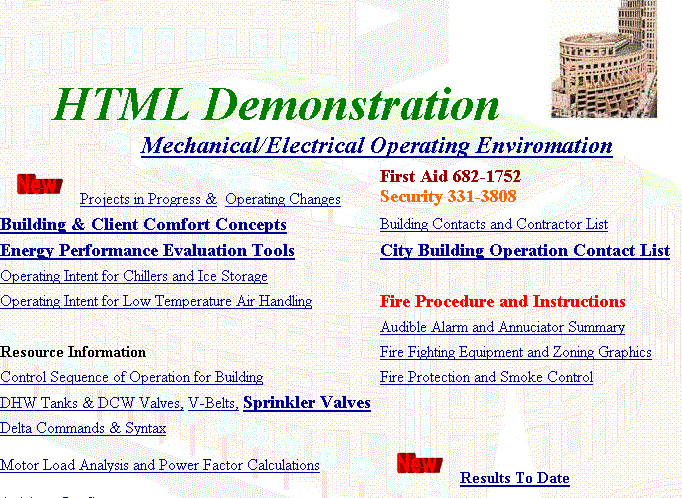
Home Page:
The first overhead shows the main menu, used to access the
many HTML “pages”. Logos and artwork can be copied from almost any source,
including web sites. This “home page” is extremely important. Access to every
piece of information should be from this screen.
Emergency information is highlighted. Fire and Security
instructions that relate to the mechanical operators are listed. The existing paper fire
plan was scanned in to allow quicker access to information. Complex smoke interfaces and
annunciator information were also added. Information which has been added in the latest
revision has a “New” label on it.
The ability to scan information in made it extremely easy to
add existing paper based information. The guiding rule was that if it was important enough
to be tacked or taped to the wall of the building operator’s room it was important
enough to be added to the HTML data set.
Five of the hypertext links are shown in larger print.
We’ll go to these now, as they illustrate many of the things I have been talking
about.
Building and Client Comfort Concepts:
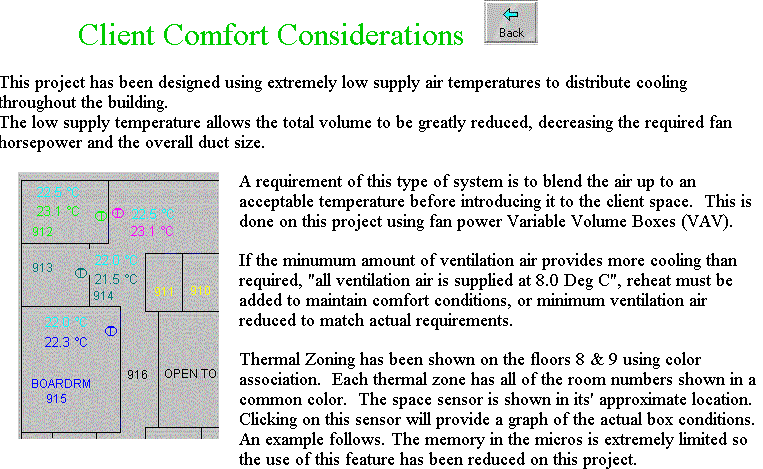
Information concerning system operation and comfort issues is
presented, supplemented by a small zoning diagram, illustrating how zones, and information
relevant to them, are presented on DDC graphic screens. Also included is a screen capture
from the DDC system which illustrates the no-load to full-load control sequence for a
typical fan-powered zone air terminal in this facility.
Note the “BACK” button which returns the user to
the home page. This feature is available on all the pages, or files, in the documentation
set.
Energy Performance Evaluation Tools:
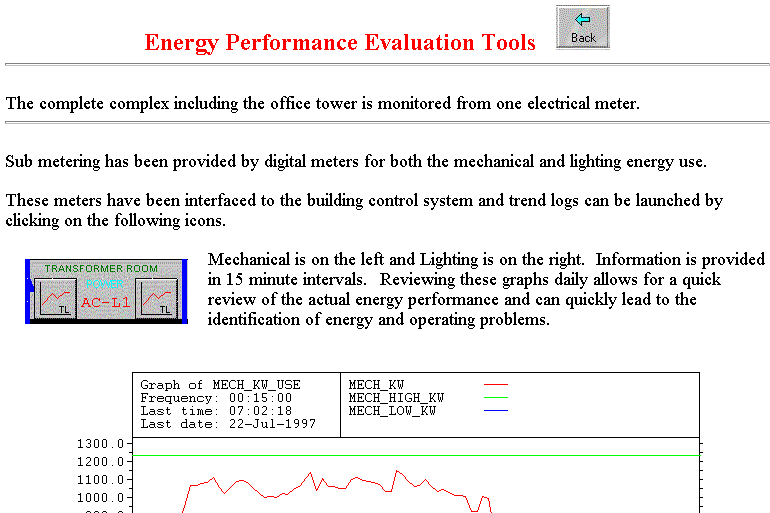
Again a mix of text and graphics are used. In this case, the
graphics illustrate typical daily electrical energy use data, based on inputs to the DDC
system from pulse meters. The “hot buttons” on the left link to real-time DDC
system trendlogs for the last full day so the operator can easily get current energy use
data.
You will note the information flows right off the bottom of
this screen capture slide. HTML pages are typically several screens long, as there is no
limit to the length of a page.
Sprinkler Valves:

This sprinkler drawing is a good example of including
information of particular relevance to operators. The only available drawing was a hand
sketch that was scanned in and is now readily accessible to all operators.
Note the bars at the bottom and right of the screen. They
indicate the scrolling necessary to see the rest of this drawing.
City Building Operations Contact List:
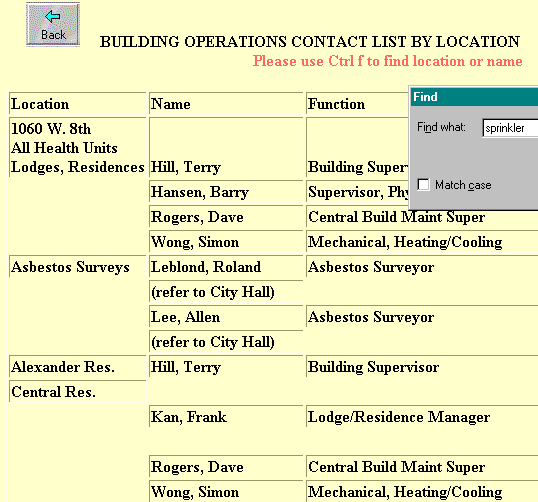
This is a complete list of contact people for all possible
situations. The inset illustrates the word search capability of HTML.
Results to Date:
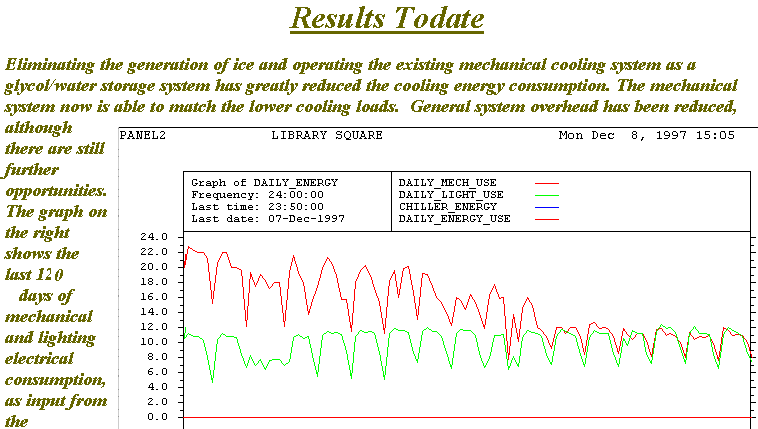
This particular O & M documentation set is not static. As
operating data become available, it can be added to the list of files. When it is, it is
labeled “NEW” on the home page. In this example, energy consumption data for
about 9 months is shown.
Post Script
My co-author has a complete working demo of this site on his
company’s web site. However, it uses our client’s data, so we prefer that you
request access to it and explain how you intend to use the site before actually doing so.
If anyone in interested in the e-mail address, please see me
after the session and I will be pleased to let you have it.
Please email sinclair@enviromation.bc.ca
if you wish to view this site and we can provide you access.
Tel: (250) 656-5378 Fax: 656-2394 : sinclair@enviromation.bc.ca
[an error occurred while processing this directive]
[Click Banner To Learn More]
[Home Page] [The
Automator] [About] [Subscribe
] [Contact
Us]






